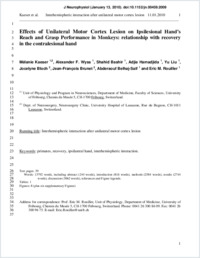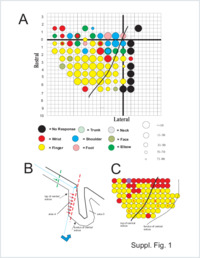Effects of unilateral motor cortex lesion on ipsilesional hand's reach and grasp performance in monkeys: relationship with recovery in the contralesional hand
- Kaeser, Mélanie Unit of Physiology and Program in Neurosciences, Department of Medicine, Faculty of Sciences,University of Fribourg, Switzerland
- Wyss, Alexander F. Unit of Physiology and Program in Neurosciences, Department of Medicine, Faculty of Sciences,University of Fribourg, Switzerland
- Bashir, Shahid Unit of Physiology and Program in Neurosciences, Department of Medicine, Faculty of Sciences,University of Fribourg, Switzerland
- Hamadjida, Adjia Unit of Physiology and Program in Neurosciences, Department of Medicine, Faculty of Sciences,University of Fribourg, Switzerland
- Liu, Yu Unit of Physiology and Program in Neurosciences, Department of Medicine, Faculty of Sciences,University of Fribourg, Switzerland
- Bloch, Jocelyne Dept. of Neurosurgery, Neurosurgery, CHUV, University of Lausanne, Switzerland
- Brunet, Jean-François Dept. of Neurosurgery, Neurosurgery, CHUV, University of Lausanne, Switzerland
- Belhaj-Saïf, Abderraouf Unit of Physiology and Program in Neurosciences, Department of Medicine, Faculty of Sciences,University of Fribourg, Switzerland
- Rouiller, Eric M. Unit of Physiology and Program in Neurosciences, Department of Medicine, Faculty of Sciences,University of Fribourg, Switzerland
-
11.01.2010
Published in:
- Journal of Neurophysiology. - 2010, vol. 103, no. 3, p. 1630-1645
English
Manual dexterity, a prerogative of primates, is under the control of the corticospinal (CS) tract. As 90-95% of CS axons decussate, it is assumed that this control is exerted essentially on the contralateral hand. Consistently, unilateral lesion of the hand representation in the motor cortex is followed by a complete loss of dexterity of the contralesional hand. During the months following lesion, spontaneous recovery of manual dexterity takes place to a highly variable extent across subjects, although largely incomplete. In the present study, we tested the hypothesis that after a significant post-lesion period, manual performance in the ipsilesional hand is correlated with the extent of functional recovery in the contralesional hand. To this aim, ten adult macaque monkeys were subjected to permanent unilateral motor cortex lesion. Monkeys' manual performance was assessed for each hand during several months post-lesion, using our standard behavioral test (modified Brinkman board task) that provides a quantitative measure of reach and grasp ability. The ipsilesional hand's performance was found to be significantly enhanced on the long-term (100-300 days post-lesion) in 6 out of 10 monkeys, with the six exhibiting the best, though incomplete, recovery of the contralesional hand. There was a statistically significant correlation (r=0.932; p0.001) between performance in the ipsilesional hand after significant post-lesion period and the extent of recovery of the contralesional hand. This observation is interpreted in terms of different possible mechanisms of recovery, dependent on the recruitment of motor areas in the lesioned and/or intact hemispheres.
- Faculty
- Faculté des sciences et de médecine
- Department
- Département de Médecine
- Language
-
- English
- Classification
- Biological sciences
- License
- License undefined
- Identifiers
-
- RERO DOC 17299
- DOI 10.1152/jn.00459.2009
- Persistent URL
- https://folia.unifr.ch/unifr/documents/301224
Other files
Statistics
Document views: 77
File downloads:
- rouiller_eum.pdf: 178
- rouiller_eum_sm.pdf: 103

